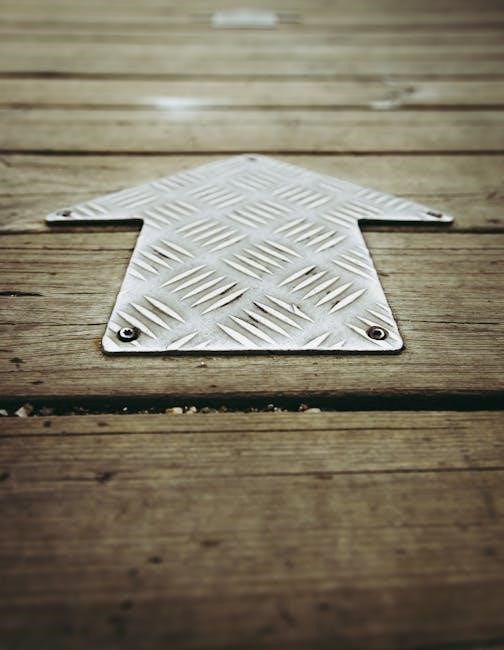The AWC Deck Guide is a comprehensive resource for designing and building safe‚ durable decks‚ updated to include 2012 IRC provisions and essential design considerations.

Key Components of a Deck
The key components of a deck include beams‚ joists‚ posts‚ and decking boards‚ each playing a crucial role in structural integrity and ensuring safety.
2.1 Beams
Beams are critical horizontal structural elements that span between posts or footings‚ distributing the deck’s load evenly. They are typically constructed using double or triple 2x lumber‚ depending on the span length and load requirements. Proper sizing and material selection are essential to ensure the deck’s stability and safety. The AWC Deck Guide provides detailed tables and formulas to determine the appropriate beam size based on the deck’s design load and span. Beams must be securely fastened to posts and footings to maintain structural integrity. Improperly sized or installed beams can lead to deck failure‚ making adherence to the guide’s specifications crucial. Regular inspection of beams is also recommended to identify and address any potential issues early.
2.2 Joists
Joists are horizontal structural members that span between beams or ledger boards‚ supporting the deck boards and additional loads. Typically constructed from pressure-treated lumber‚ joists are spaced at standard intervals‚ usually 16 or 20 inches on-center‚ depending on deck board thickness and desired stiffness. Proper joist sizing is critical to ensure the deck can withstand intended loads without deflection. The AWC Deck Guide provides tables and formulas to determine the appropriate joist size based on span length and load requirements. Joists must be securely fastened to beams and ledger boards using approved connectors. Improperly spaced or sized joists can lead to structural issues‚ emphasizing the importance of adhering to the guide’s specifications. Regular inspection of joists is recommended to ensure long-term safety and performance.
2.3 Posts
Posts are the vertical structural elements that transfer loads from the deck beams to the footings and foundation. They are typically constructed from pressure-treated lumber to resist rot and insect damage. The AWC Deck Guide specifies minimum post sizes‚ such as 6×6 nominal lumber‚ and provides guidance on maximum allowable heights to ensure stability. Posts must be installed plumb and securely anchored to both the beams above and the footings below. Proper hardware‚ like post-base connectors‚ is essential to maintain structural integrity. Posts play a critical role in ensuring the safety and durability of the deck‚ making their correct sizing and installation paramount. Regular inspection of posts is recommended to identify any signs of damage or deterioration early.

Deck Framing Plan
A deck framing plan outlines the structural layout‚ including beams‚ joists‚ and posts‚ ensuring proper load distribution and compliance with building codes. It guides the placement of components for safety and durability.
3.1 Design Considerations
Design considerations for a deck involve assessing the intended use‚ load-bearing capacity‚ and adherence to local building codes. Factors such as the number of users‚ furniture‚ and additional features like hot tubs or grills must be accounted for to ensure structural integrity. Proper material selection‚ including lumber grade and treatment‚ is crucial for durability and safety. The layout should also consider drainage and slope to prevent water accumulation. Spacing and alignment of beams and joists must be precise to distribute weight evenly. Additionally‚ the design should incorporate aesthetic elements while maintaining functionality. Compliance with the 2012 International Residential Code (IRC) provisions‚ as outlined in the AWC Deck Guide‚ ensures that the structure meets safety standards. Planning meticulously during this phase minimizes risks and ensures a sturdy‚ long-lasting deck.
3.2 Load Calculations
Load calculations are critical for ensuring a deck’s structural integrity and safety. The AWC Deck Guide emphasizes calculating both dead loads (weight of materials) and live loads (people‚ furniture). Minimum live load for decks is typically 40 psf. Proper load distribution across beams and joists is essential to prevent structural failure. Material selection and spacing must align with calculated loads. The guide provides tables‚ such as Table 4‚ to determine maximum post heights based on load requirements. Accurate calculations ensure the deck can support intended uses without compromising safety. Compliance with these standards is vital for meeting local building codes and ensuring long-term durability. Always refer to the AWC Deck Guide for detailed guidance on load-bearing capacities and structural requirements.

Post Size and Height Requirements
Post size and height are critical for deck stability and safety. The AWC Deck Guide specifies that the minimum post size is 6×6 nominal‚ with maximum heights determined by Table 4. Posts must be spaced and aligned properly to ensure even load distribution. Material selection‚ such as pressure-treated lumber‚ is recommended for posts in contact with the ground to prevent rot and insect damage. Proper post height ensures the deck remains level and securely attached to the ledger board. Additionally‚ footings must be sized to support post loads. Always verify local building codes for specific requirements‚ as they may exceed the guide’s recommendations. Adhering to these guidelines ensures structural integrity and long-term safety for the deck and its users.

Footing and Foundation Details
Footing and foundation details are essential for ensuring the structural integrity of a deck. The AWC Deck Guide provides specific requirements for footing size‚ depth‚ and spacing to support deck loads. Minimum footing size is typically 12 inches deep and 18 inches wide‚ but this may vary based on local soil conditions and load calculations. Footings must be placed below the frost line to prevent shifting due to freeze-thaw cycles. Properly reinforced concrete footings are recommended for durability. It is crucial to consult local building codes‚ as they may impose additional requirements. Improper footing installation can lead to deck instability or collapse. Always ensure footings are level and securely anchor posts to the foundation. This section builds on the post size and height requirements‚ ensuring a solid base for the entire deck structure. Adhere to these guidelines for a safe and long-lasting deck.
Deck Board Installation
Deck board installation requires careful planning to ensure a sturdy and visually appealing surface. The AWC Deck Guide recommends spacing deck boards appropriately to allow for expansion and contraction due to temperature changes. Typically‚ a 1/4-inch gap is suggested between boards. Use screws or hidden fasteners to secure boards‚ avoiding nails for better durability. Always pre-drill holes to prevent splitting‚ especially near board ends. Boards should be installed perpendicular to the joists for optimal structural support. Consider the type of wood or composite material when selecting fasteners to prevent damage. Properly aligning boards ensures even weight distribution and enhances safety. Regularly inspect boards for defects or wear and address issues promptly. This section provides detailed guidance for achieving a professional-grade deck surface. Follow these steps to ensure a long-lasting and attractive deck. Always adhere to manufacturer specifications for materials and tools to achieve the best results. Safety should be a top priority during installation.
Railings and Guardrails
Railings and guardrails are critical for deck safety‚ providing structural support and preventing falls. The AWC Deck Guide outlines specific requirements for railing height‚ material‚ and design. Typically‚ railings must be at least 36 inches tall‚ with balusters spaced no more than 4 inches apart to ensure safety‚ especially for children. Guardrails are required on any deck more than 30 inches above grade. Materials should be durable and weather-resistant‚ such as pressure-treated wood‚ composite‚ or metal. Proper installation ensures stability‚ with posts securely anchored to the deck frame. The guide also emphasizes adherence to local building codes and load requirements. Regular inspection of railings is essential to maintain safety and longevity. Always follow manufacturer guidelines for hardware and fasteners to ensure a secure and attractive railing system.

Compliance with Building Codes
Compliance with local building codes is essential for ensuring deck safety and structural integrity. The AWC Deck Guide aligns with the International Residential Code (IRC) and provides detailed guidance to meet regulatory requirements. Key aspects include load calculations‚ material specifications‚ and construction practices. Proper permits and inspections are mandatory to verify adherence to codes. The guide emphasizes the importance of understanding and applying local ordinances‚ as they may vary by region. Failure to comply can result in structural hazards‚ legal issues‚ or costly modifications. Always consult local building authorities to ensure your deck design and construction meet all applicable codes and standards.

Maintenance and Inspection Tips
Regular maintenance and inspections are crucial to ensure the longevity and safety of your deck. Inspect for rot‚ decay‚ or insect damage‚ especially in areas prone to moisture; Check fasteners for tightness and replace any corroded or loose hardware. Clean debris from between deck boards to prevent water accumulation and mold growth. Apply protective sealants or finishes as needed to preserve the wood. Seasonal inspections‚ particularly before heavy use or extreme weather‚ can help identify potential issues early. Address any damage promptly to prevent structural weakening. Keep vegetation trimmed to reduce moisture retention and pest activity. A well-maintained deck not only enhances safety but also maintains its aesthetic appeal and value.